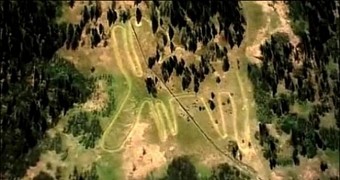Some time ago, in 2011, a researcher named Alexander Shestakov came across a previously undocumented geoglyph while exploring Russia's Ural Mountains.
The geoglyph, a photo of which is available next to this article, is said to be a representation of a moose. Having taken the time to study it, scientists found that it was created some 6,000 years ago.
This means that it is one of the oldest artistic creations of this kind to have until now been discovered anywhere in the world. By comparison, geoglyphs in the Nazca Desert in southern Peru only date back to between 500BC and 500AD.
Children helped create it
Earlier this week, archaeologists announced that, while busy studying the ancient structure and its surroundings in further detail, they came across several tools that our ancestors almost certainly used to create this geoglyph in Russia.
The thing is that, of these tools that researchers found hidden in the Ural Mountains, some are freakishly small. This could mean that the culture that created the representation of a moose had children work on this geoglyph as well.
“Judging by the different sizes of tool – from 17 centimeters [2.7 inches] long and weighing about 3 kilograms [6.6 pounds] to some being just 2 centimeters [0.8 inches] – we can assume they were used by both adults and children,” said researcher Stanislav Grigoryev.
Mind you, kids were given tools and asked to help create the artwork not because our ancestors believed in child labor. On the contrary, archaeologists suggest that they were made to participate in this project to reinforce their ties with the community.
“It was not a kind of slave labor of children. They were involved to share common values, to join something important to all the people,” specialist Stanislav Grygoryev with the Chelyabinsk History and Archeology Institute explained, as cited by Ancient Origins.
How the geoglyph was created
It is understood that, to make this ancient artwork, our ancestors started by creating ditches arranged in such way that they mimicked the outline of a moose's body. They then filled these ditches with stones. To create the moose's hooves, they used a mixture of crushed stones and clay.
The geoglyph, best observed from above, measures some 275 meters (approximately 900 feet) in length. The ditches that form it are 30 centimeters (12 inches) deep. Their width ranges between 4.5 meters (15 feet) and 10 meters (32 feet).
This is yet to be confirmed, but researchers suspect that the culture that created this moose representation did it to appease the gods. Archaeologists plan to explore the site of this ancient structure in further detail, and hope to soon learn more about how and why it was created.

 14 DAY TRIAL //
14 DAY TRIAL //